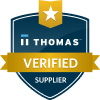Clearance, preloading, and fit are common engineering concepts that also apply to the rolling bearing, for which they have crucial importance. At Emerson Bearing, we want to make sure that your bearing selection is perfect for your design. In this post, we will discuss clearance fits and preloads.
Understanding Bearing Clearance: Definition and Types
The space between a bearing's rolling elements and its outer and inner raceways is known as bearing clearance. Like other elements of a bearing's precision-engineered design, proper clearance is critical to bearing functionality and longevity. If this gap is too tight or too wide, it can cause premature ball or roller bearing failure and suboptimal equipment performance. Understanding the need for bearing clearance and the various types can help you avoid failed bearings as well as the productivity losses and costs associated with damaged equipment.
For example, it's important to delineate between initial and operating clearance. The former refers to the bearing before it’s mounted and the latter when the bearing is mounted and has reached a steady temperature. As a general rule, a ball bearing should have an almost-zero operational clearance, while needle, spherical, cylindrical, and CARB toroidal bearings should always have some residual radial operational clearance.
Bearing Clearance Types
Two types of bearing clearance are radial and axial clearance. The play between a ball and raceway perpendicular to the bearing axis is the radial clearance. Axial clearance, which is typically a minimum of 10 times the radial clearance, is the play parallel to the bearing axis.
Insufficient or excessive internal clearance significantly impacts such factors as noise, vibration, fatigue life, and heat. Radial bearing clearance falls into several categories: C1, C2, CN, C3, C4, and C5. CN is the “normal clearance” and is defined by DIN 620 and ISO 5753. It's used for bearings in normal operating conditions. C1 and C2 class bearings have radial clearances smaller than CN.
Low- and High-Temperature Applications
It's important to note that, in applications that must withstand particularly low or high temperatures, the clearance has to be taken into account early in the design process in order to make sure that the clearance is compensated for. This is due to the thermal contraction and expansion of the shaft and housing.
Bearing Fits in Assemblies
How a bearing fits into your assembly is also a major factor in its performance. In general, the bearing’s inner ring should have a tight fit on the shaft, and the outer ring should have a tight fit in the housing.
For more details about mechanical fits, you can refer to mechanical tolerance standard charts, or contact us at Emerson Bearing. We'd be delighted to guide you through this process and make sure that your bearing and shaft have the appropriate size for your design.
Role of Preload in Bearing Functionality
Bearing preload is the thrust or axial load on a bearing that serves to eliminate excess play, or too much clearance in ball bearings' designs. Nearly all radial ball bearings are engineered with a clearance between their parts, enabling them to move freely. However, if this clearance isn't taken up by a bearing preload, the bearing's rolling elements may slide instead of rolling like they're meant to. In such cases, there's the potential for race misalignment.
Applications of Preloading
Preloading is a good idea for bearings under a very light load at high speeds for preventing bearing slip or creep in machine tools. It's also ideal for pinion bearings in automotive axle drives where some extra rigidity in the bearing is needed.
Methods of Preloading
There are two main methods for preloading a bearing: position preload and constant-pressure preload. The type of preload that’s best for you depends on your application. Generally speaking, position preloading increases the rigidity of the bearing, and constant-pressure preloading reduces axial vibrations in high-speed applications.
Preloading Precautions
Be careful not to overdo it on preloading bearings. If too much preload is applied, you can increase the energy dissipated by the bearing, increase power consumption, and decrease bearing life. Again, if you have questions, give us a call and we’ll discuss your application.
Why Choose Emerson Bearing?
Over our 50+ years in business, Emerson Bearing has developed a reputation for delivering high-quality ball and roller bearings to customers across the world. Our extensive background in the industry enables us to help clients solve complex bearing challenges as part of a one-stop shopping experience.
Emerson Bearing maintains a vast inventory of bearings ranging from 5-foot steel mill bearings to precision miniature bearings with IDs of 3 millimeters. We also utilize our Worldwide Sourcing Network to streamline the procurement process for bearings and related products from such major manufacturers as Timken, NTN, NSK, FAG, IKO, and more. With same-day shipping and round-the-clock support, we strive to ensure our customer service quality and convenience match that of our high-performance product offerings.
At Emerson Bearing, we'll help you find the right fit for your application and budget. Contact us for more information, request a quote today, or visit our Catalog and Technical Toolbox web pages to find the right bearing for you.






